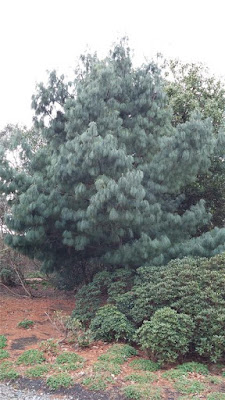Pinus bhutanica is restricted to Bhutan and adjacent parts of northeast India (Arunachal Pradesh) and southwest China (Yunnan and Tibet). It has been reported from a variety of forest types, including secondary forest where logging has occurred.
Pinus bhutanica also called as Bhutan white pine, is a species of the genus Pinus. This species was described by Grierson, Long & Page in 1980.
IDENTIFY PINUS BHUTANICA - BLUE WHITE PINE PLANTS
Pinus bhutanica is restricted to Bhutan and adjacent parts of northeast India (Arunachal Pradesh) and southwest China (Yunnan and Tibet). It has been reported from a variety of forest types, including secondary forest where logging has occurred.
Bhutan white pine is a tree which reaching up to 25 m tall or more with moderately open, not twiggy crown that has spreading, drooping, sinuous branches (1st-year branchlets conspicuously whitish bloomed, glandular pubescent; 2nd-year branchlets with thin, pale gray-green bark).
Their needles shed in 2nd year, 5 per bundle, pendulous, very slender, curved, triangular in cross section, 15-24 cm, adaxial surface grass green with no stomata, 2 abaxial surfaces conspicuously whitish bloomed, each with 4-7 stomatal lines, resin canals 3(or 4), adaxial 2 marginal or submarginal, abaxial 1(or 2) marginal or submarginal and always asymmetrically placed.
Seed cones pedunculate (peduncle (1-) 4.5-6 cm), elongate-cylindric, 12-20 × 3-4 cm (5-7 cm wide when open). Seed scales rather elongate, thinly woody, base cuneate; apophyses rhombic, 1-1.5 × 1.5-2.5 cm, keeled, apex subacute. Seeds brown, obovoid, compressed, 6-8 × 4-5 mm; wing persistent, ca. 2 × 0.7-1 cm.
This conifers is differs from Pinus wallichiana in the much longer, strongly drooping needles, and the cones being slightly smaller and red-brown, rather than yellow-buff, when mature. It is also adapted to generally warmer, wetter climates at lower altitudes, with an intense summer monsoon.
PINUS BHUTANICA - BLUE WHITE PINE PLANTS CARE AND CULTIVATION
The cultivation of these plants presents no special difficulties, if proper soil and exposure are available. The question of hardiness is, of course, all-important. It is not only the problem of temperature the given tree will stand, but also the exposure to winds, and, to a considerable extent, the source from which the tree is derived. If the plants are raised from seeds matured in similar or even more rigorous climates, they are usually more hardy.
Soils:
Pinus bhutanica prefer a well-drained porous gravelly subsoil, overlaid with a light sandy loam. They seem to be particularly happy in a soil underlaid with a porous glacial drift. In cultivation, however, they succeed very well in ordinary well-drained soil. When the plants are set in clay soil, which is often done, the soil should be thoroughly loosened by trenching or subsoil plowing, and well underdrained. Any available humus, woodashes, and well-rotted manure incorporated in the soil greatly aid in rendering it friable and porous for the roots.
Manures and mulches:
Mulching with ordinary well-rotted barnyard manure in late autumn affords much stimulus to growth. By the following spring the manure will be in a desiccated condition and can be incorporated with the soil. A heavy mulch of old straw, rotten hay, or any similar material over the roots, and this was maintained throughout the entire growing season is benefit to the plants in a more or less juvenile condition.
In many cases manure is not obtainable. In such event, newly moved plants should be heavily mulched with rotten straw, rotten hay, or any similar rubbish for a few years until they become established. The frequent stirring of the ground over the roots subsequently will conserve sufficient moisture.
An area extending from the stem to one to two feet beyond the branches, stirred up with hoe and rake perhaps five or six times throughout the growing season, is very beneficial in conserving the moisture around the roots.
Pruning:
Removal of the lower branches of Bhutan white pine is a serious mistake, and, if healthy, they should be retained to the base. Pruning or disbudding can be intelligently performed to add much to the natural symmetry. The extraction or removal, early in spring, of the central or terminal bud, will tend to compel the branches which start from the side buds to spread apart and form a much denser growth. Cutting back the previous year's terminal growth to a strong bud or branchlet on the main limbs over the tree, if the plant is inclined to be thin in its branching, always produces a much denser lateral growth.
Transplanting:
Transplanting can be done at all times of the year, excepting midsummer when they are in full growth. The best success is secured in spring when the buds begin to swell. From the end of August to the middle of September, if there have been abundant rains and the ground has been well soaked, is a very good time to move the plants. They may be planted late in autumn when circumstances compel it, but there is likely to be a considerable percentage of loss. Their roots are very susceptible to injury from exposure to the air, and the utmost vigilance should be exercised to keep them covered and moist.

















COMMENTS